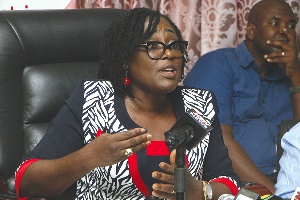 Executive Director of the NRSC, May Obiri-Yeboah
Executive Director of the NRSC, May Obiri-Yeboah
The National Road Safety Commission (NRSC) has appealed to the executive and the legislature to fast-track and pass into law a bill that will change its current awareness creation status to a regulator.
The commission believes that the change of status will empower the commission to play a major role, given that it would have the ‘teeth to bite’ partner agencies and compel them to do the right thing.
Speaking to The Finder, Executive Director of the NRSC, Mrs May Obiri-Yeboah said there are limitations in the Legislative Instrument that established them, hence the need for the change.
She stated that the commission lacked the powers to sanction stakeholders for dereliction of duty.
Currently, “if stakeholders refuse to take our recommendations, nothing happens”, she said.
For instance, she added that if the Motor Traffic and Transport Department of the Ghana Police Service receive a recommendation from the National Road Safety Commission to enforce traffic regulations and they don’t do it, the NRSC has no power to act and sanction them.
She explained that a legal backing would empower the regulator to demand compliance from stakeholders, such as the Driver and Vehicle Licensing Authority (DVLA) and the Motor Traffic and Transport Department (MTTD) of the Ghana Police, and in default, apply sanctions.
She was optimistic that when transformed into a regulator and given the needed resources, the increasing spate of road accidents would be brought under control.
Mrs Obiri-Yeboah explained that when granted a regulator status, it would deploy safety inspectors to help with compliance.
With a regulator status, she said, inspectors who identify rickety vehicles with road worthy certificates would inform the regulator to find out from DVLA how such vehicles obtained the certificates.
Findings of safety audits hardly addressed
She stated that NRSC conducts safety audits on the roads and make recommendations to the road agencies for redress, but such recommendations were hardly addressed.
She said the commission was worried about the situation, but under its current mandate, it cannot do much to change it.
“For example, the commission is not happy about the unsafe situation on the George Walker Bush Highway, Pokuase, Amasaman and the Tetteh Quarshie-Madina-Adenta road, where pedestrians are always seen competing with speeding vehicular traffic and resulting in knockdowns and deaths.
“The commission conducted an inspection of the interchange at Suhum Junction a couple of weeks ago, and our observation is that there is a looming danger for pedestrians at both approaches to the interchange if facilities to separate vehicular and pedestrian traffic are not put in place now before commissioning of the road.
“These observations have been communicated to the Ghana Highway Authority to consider,” she said.
180 Killed in January 2018
The rate of accidents and the number of casualties have increased in January 2018, compared to the same period last year.
The number of people killed in January this year has risen to 180, as against the 163 killed in January 2017, representing 10.43% increase.
Gender of person killed
The fatalities comprised 131 males and 49 females.
2,076 Die in road accidents in 2017
A total of 2,076 people died in road traffic accidents in 2017.
This is eight people less than the 2,084 people killed in 2016.
514 Females killed in 2017
A total of 514 females, comprising 379 above 18 years and 135 below 18 years, were killed in 2017.
1,562 Males killed in 2017
Similarly, 1,562 males, made up of 1,369 persons above 18 years and 193 people below 18 years, also perished last year.
879 Pedestrians killed in 2017
Out of the 3,300 pedestrian knockdowns last year, 879 were killed while 2,421 survived their injuries.
12,166 Travellers injured
According to the data, 12,166 travellers were injured in 2017, compared to 12,522 in 2016.
20,444 Vehicles involved in accidents
The data puts the total number of motor vehicles involved in accidents in 2017 at 20,444.
Types of motor vehicles involved
The breakdown of category of motor vehicles involved is 8,080 commercial vehicles, 8,877 private vehicles, and 3,487 motorcycles.
Eastern Region tops regional breakdown of deaths
The regional breakdown of persons killed from highest to lowest is Eastern – 374; Ashanti – 335; Accra – 296; Brong Ahafo – 253; Central – 193; Northern – 136; Tema – 125; Western – 125; Volta – 120; Upper West – 61; and Upper East – 58.
Breakdown of pedestrian knockdowns
The regional breakdown of pedestrian knockdowns is Accra – 1,196; Tema – 200; Eastern – 404; Central – 307; Western – 161; Ashanti – 652; Volta – 150; Northern – 47; Upper West – 16; Upper East – 29; and Brong Ahafo – 138.
Regional breakdown of pedestrians killed
For the regional breakdown of pedestrians killed, the figures are Accra – 238; Tema – 61; Eastern – 131; Central – 91; Western – 57; Ashanti – 129; Volta – 49; Northern – 37; Upper West – eight; Upper East – 12; and Brong Ahafo – 66.
Breakdown of pedestrian deaths
For the regional breakdown of pedestrians killed, the figures are Accra – 238; Tema – 61; Eastern – 131; Central – 91; Western – 57; Ashanti – 129; Volta – 49; Northern – 37; Upper West – eight; Upper East – 12; and Brong Ahafo – 66.
Accra tops accidents
On regional breakdown of motor vehicle accidents, the figures are Accra – 8,893; Ashanti – 3,551; Eastern – 1,724; Tema – 1,510; Central – 1,422; Volta – 823; Western – 781; Brong Ahafo – 722; Northern – 467; Upper East – 330; and Upper West – 221.